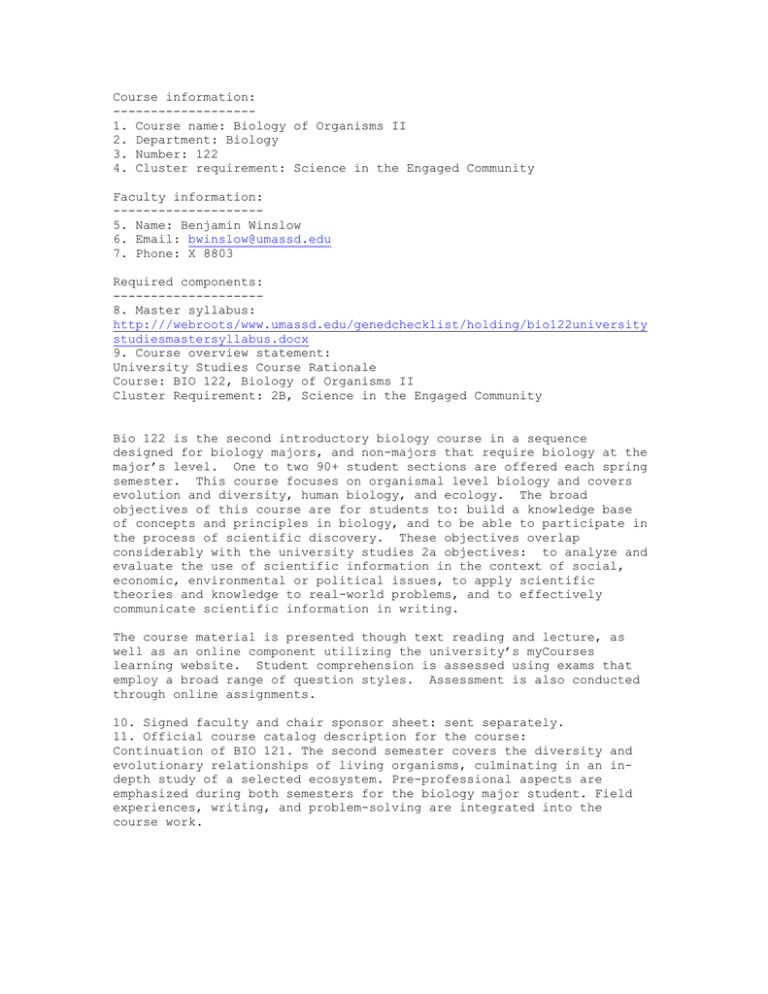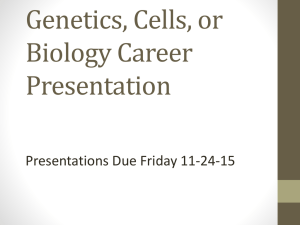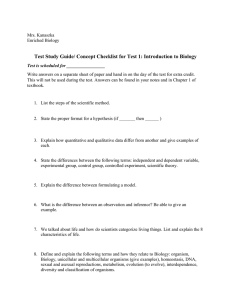Course information: ------------------- 1. Course name: Biology of Organisms II 2. Department: Biology
advertisement

Course information: ------------------1. Course name: Biology of Organisms II 2. Department: Biology 3. Number: 122 4. Cluster requirement: Science in the Engaged Community Faculty information: -------------------5. Name: Benjamin Winslow 6. Email: bwinslow@umassd.edu 7. Phone: X 8803 Required components: -------------------8. Master syllabus: http:///webroots/www.umassd.edu/genedchecklist/holding/bio122university studiesmastersyllabus.docx 9. Course overview statement: University Studies Course Rationale Course: BIO 122, Biology of Organisms II Cluster Requirement: 2B, Science in the Engaged Community Bio 122 is the second introductory biology course in a sequence designed for biology majors, and non-majors that require biology at the major’s level. One to two 90+ student sections are offered each spring semester. This course focuses on organismal level biology and covers evolution and diversity, human biology, and ecology. The broad objectives of this course are for students to: build a knowledge base of concepts and principles in biology, and to be able to participate in the process of scientific discovery. These objectives overlap considerably with the university studies 2a objectives: to analyze and evaluate the use of scientific information in the context of social, economic, environmental or political issues, to apply scientific theories and knowledge to real-world problems, and to effectively communicate scientific information in writing. The course material is presented though text reading and lecture, as well as an online component utilizing the university’s myCourses learning website. Student comprehension is assessed using exams that employ a broad range of question styles. Assessment is also conducted through online assignments. 10. Signed faculty and chair sponsor sheet: sent separately. 11. Official course catalog description for the course: Continuation of BIO 121. The second semester covers the diversity and evolutionary relationships of living organisms, culminating in an indepth study of a selected ecosystem. Pre-professional aspects are emphasized during both semesters for the biology major student. Field experiences, writing, and problem-solving are integrated into the course work. Master Syllabus Course: BIO 122, Biology of Organisms II Cluster Requirement: 2B, Science in the Engaged Community This University Studies Master Syllabus serves as a guide and standard for all instructors teaching an approved course in the University Studies program. Individual instructors have full academic freedom in teaching their courses, but as a condition of course approval, agree to focus on the outcomes listed below, to cover the identified material, to use these or comparable assignments as part of the course work, and to make available the agreed-upon artifacts for assessment of learning outcomes. Course Overview: BIO 122 is designed for biology majors and non-majors that require science at the major’s level. Bio 121 is a prerequisite for this course that adds new concepts, and reinforces some concepts covered in bio 121. Bio 122 focuses on organismal level biology (rather than cell and molecular). Material is presented through assigned text readings, lectures, and includes an online component using the university’s myCourses system. Student learning is assessed by short in class assignments, online quizzes, and in class exams using a broad range of question styles. Learning Outcomes: Course-specific Learning Outcomes: After completion of the course students will be able to: 1. Be able to propose hypotheses and devise ways of testing them 2. Interpret data regarding specific hypotheses 3. Explain major concepts such as natural selection and homeostasis 4. Apply concepts in problem solving activities University Studies Learning Outcomes: Cluster 2B, Science in the Engaged Community. After completing the course, students will be able to: 1. Analyze and evaluate the use of scientific information in the context of social, economic, environmental or political issues. 2. Apply scientific theories and knowledge to real‐world problems. 3. Effectively communicate scientific information in writing. Example Text: Campbell Biology, 10th ed. By Reece, Urry, Cain, Wasserman, Minorsky, Jackson. Pearson publishing, 2014. Example Assignments: Learning outcomes of the course and from cluster 2B are assessed throughout the semester in the form of online quizzes, in class participation via iClicker responses, and exam questions. Each exam will include multiple questions that require a written short answer or medium length answer. Potential exam questions are given below. Outcome 1: Analyze and evaluate the use of scientific information in the context of social, economic, environmental or political issues. In January of 2014, several media outlets picked up on the fact that a decommissioned cruise ship was drifting in the Atlantic ocean, and predicted a nightmarish and scientifically absurd scenario: that the cruise ship was full of cannibal rats, and might crash into Europe releasing hundreds of cannibal rats on the continent (people really thought this, just google “cannibal rat cruise ship”). Based on what you know about energy flow in ecosystems, explain why a ship drifting at sea could not host a colony of cannibal rats. Students need to recognize that there would be no primary production in this scenario, and that approximately 90% of energy is lost from one trophic level to the next. Therefore, a species cannot survive using cannibalism for very long because their energy source would become depleted, and they could not reproduce enough new offspring to be used as a food source. This particular question addresses the use of scientific information in both a social and environmental context. Outcome 2: Apply scientific theories and knowledge to real‐world problems. How has genetically modified rice (Golden rice) been engineered to alleviate blindness and other diseases in areas where rice is a major component of the human diet? Students would need to explain that researchers have engineered rice to express vitamin A in the endosperm (giving it a golden color). This provides a source of vitamin A to rice dependent populations, potentially alleviating diseases that result from vitamin A deficiency, such as blindness. This question addresses the application of scientific knowledge (genetic modification) to the real-world problem of vitamin A deficiency in dietary limited locations. Outcome 3: Effectively communicate scientific information in writing. Surprisingly, taxonomist still do not agree on animal phylogeny (how major groups of animals are related to each other). Phylogenies constructed using morphological data generate one set of relationships, while phylogenies constructed from molecular data generate a different set of relationships. Let’s assume that the molecular based phylogeny is correct. What processes could have lead to the morphological data resulting in an incorrect phylogeny? Students would need to answer by writing approximately one paragraph explaining that convergent evolution can lead researchers to conclude that distantly related organisms are more closely related than they actually are. Additionally, students would need to address the issue of human bias in interpreting the importance of specific animal characters in evolution. Sample Course Outline: Unit 1: Biodiversity Chapters 26-28, 31-34 Unit 2: Comparative vertebrate anatomy/human biology Chapters 40-50 Unit 3: Plant biology Chapters 29-30, 35-39 Unit 4: Ecology Chapters 51-56






